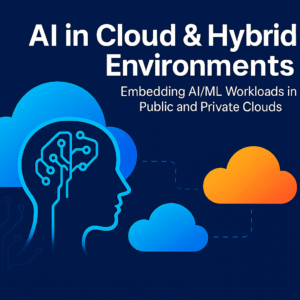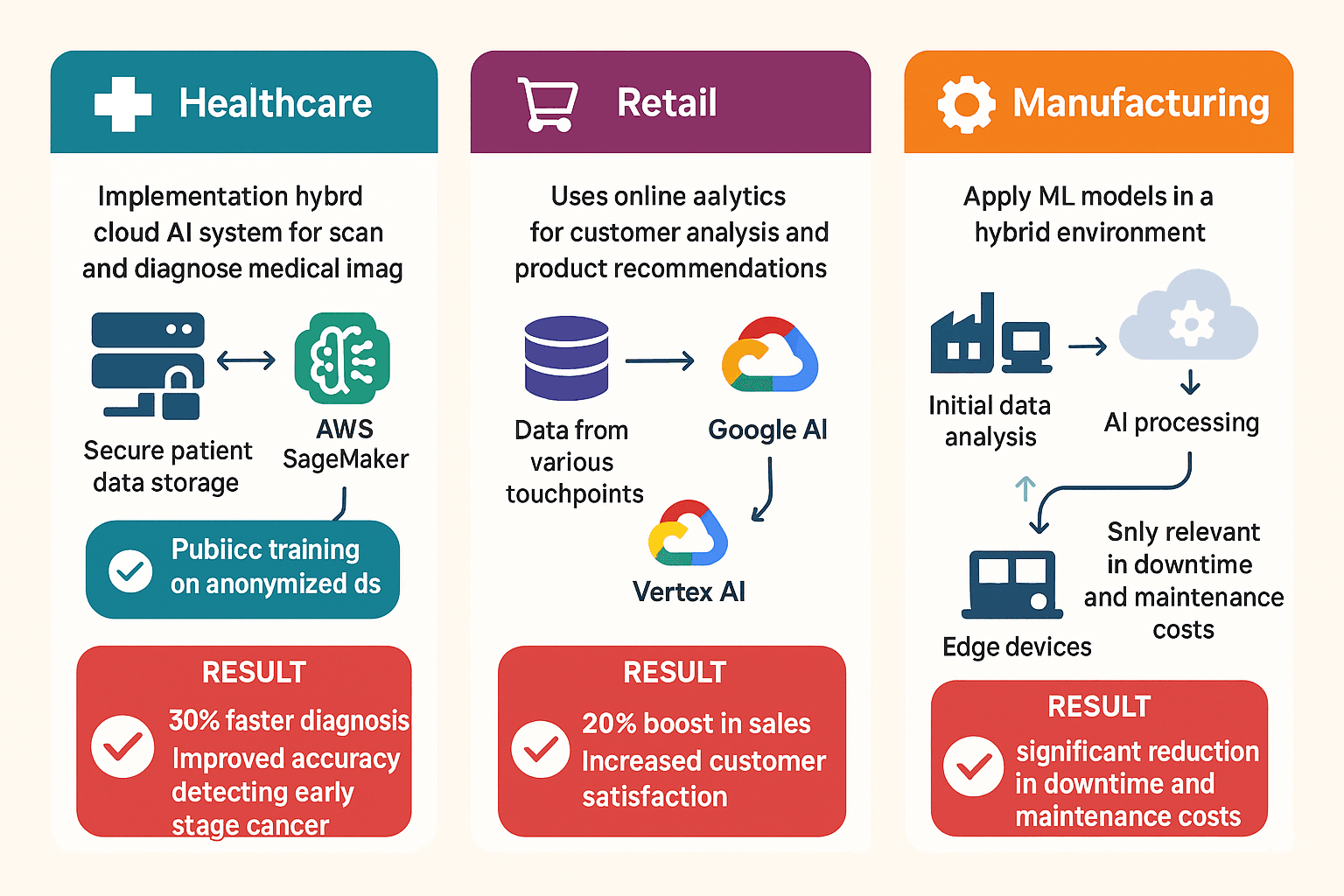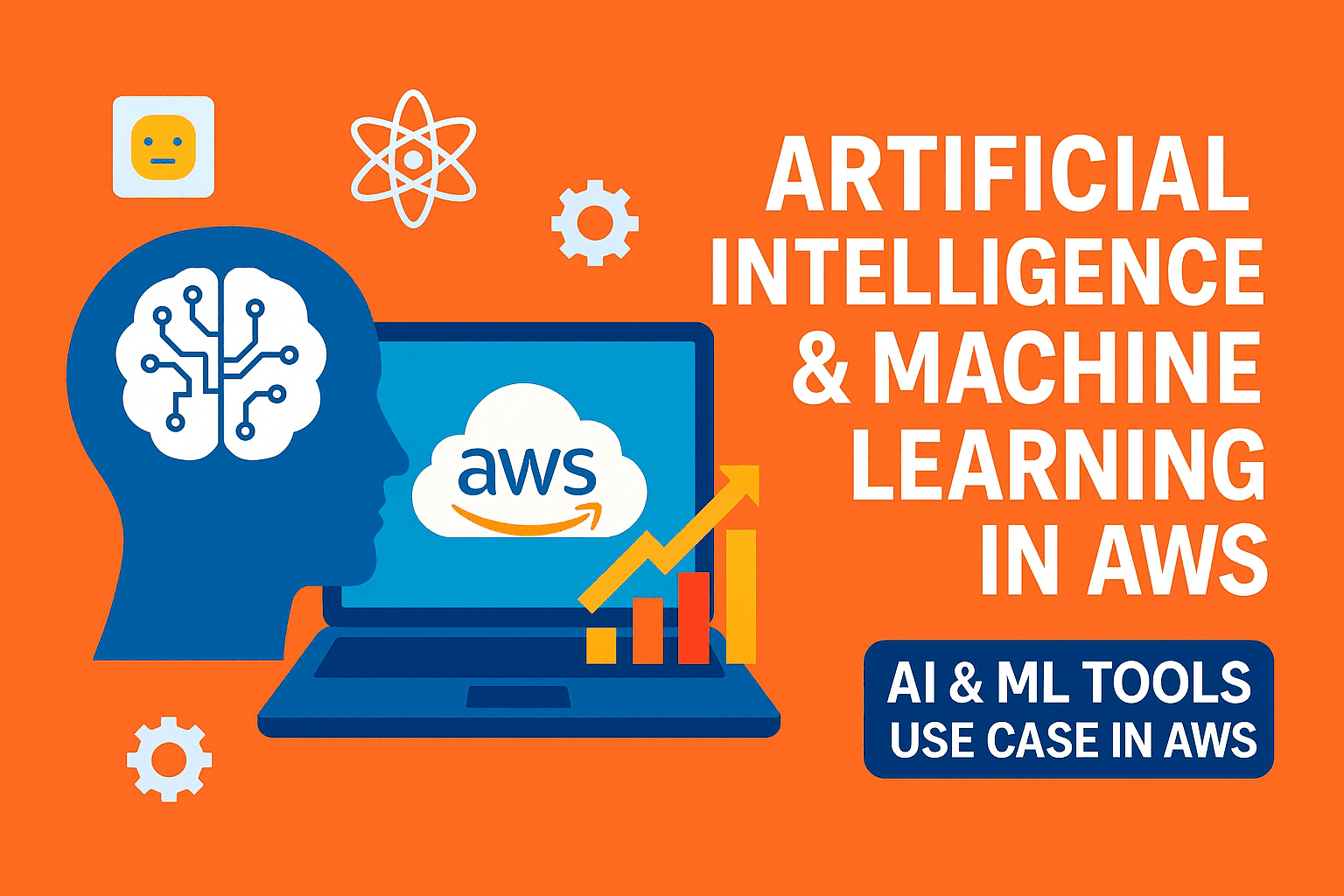Table of Contents
ToggleIntroduction:
Artificial Intelligence (AI) and Machine Learning (ML) are rapidly reshaping industries by automating decision making, optimizing processes, and creating intelligent applications.
At the same time, cloud computing (public and hybrid) has become the foundation of modern IT infrastructure. When these powerful technologies converge, businesses can unlock unmatched potential for scalability, flexibility, and innovation.
In this article, we will explore the synergy between AI and cloud computing, uncover the benefits and challenges, and share a step-by-step guide to effectively implement AI/ML in public and private clouds, Whether you are a decision-maker, cloud architect, or tech enthusiast, this guide will help you understand the value and strategy behind AI in the cloud.
Understanding the Core Concepts
What is Artificial Intelligence (AI) and Machine Learning (ML)?
AI is a field of computer science focused on creating systems capable of performing tasks that typically require human intelligence. These tasks include image recognition, natural language processing, decision-making, and predictive analytics.
ML is a subset of AI that enables systems to learn from data and improve over time without explicit programming. ML algorithms identify patterns, make predictions, and automate decision making.
What is Cloud Environments ?
Cloud Environment delivers on-demand computing resources, such as servers, storage, databases, networking, and software over the internet. Major providers include Amazon Web Services (AWS), Microsoft Azure, and Google Cloud Platform (GCP). it can be:
Public: Hosted and managed by third-party vendors, offering resources over the internet.
Private: Dedicated infrastructure operated solely for one organization, either on-premises or hosted by a third party
Hybrid Cloud Setup
Hybrid cloud combines public and private cloud infrastructures, enabling data and applications to move seamlessly between them. This setup allows businesses with greater control, flexibility, and optimized resource utilization and enabling organizations to run sensitive data or critical workloads privately, while leveraging the public cloud’s scalability for less-sensitive tasks like AI model training or big data analysis.
Benefits of Embedding AI/ML Workloads in Cloud & Hybrid Environments
- Scalability : Cloud environments can elastically scale resources up or down based on demand. Training ML models on large datasets or deploying AI-powered apps to millions of users is seamless in the cloud.
- Flexibility & Agility : Hybrid setups allow organizations to select the right environment for each workload. Sensitive data can remain on private clouds, while less-critical tasks leverage public cloud scalability.
- Cost-Effectiveness : Pay-as-you-go pricing models in the cloud help organizations avoid heavy upfront investments in infrastructure. Businesses only pay for the resources they use.
- Accelerated Innovation : Cloud providers offer pre-built AI/ML services, APIs, and tools, enabling faster development, experimentation, and deployment.
- Enhanced Security & Compliance : Private clouds and hybrid models allow organizations to meet strict regulatory requirements by keeping sensitive workloads on-premises while still taking advantage of public cloud capabilities for less regulated tasks.
Challenges of Embedding AI/ML Workloads (and Solutions)
1. Data Security & Privacy
- Challenge: Transferring sensitive data to the cloud can create privacy risks and compliance issues.
- Solution: Use encryption, anonymization, and access controls. Leverage hybrid clouds to process sensitive data in private environment.
2. Data Transfer & Latency
- Challenge: Moving large datasets between on-premises and cloud can be slow and costly.
- Solution: Employ data compression, edge computing, or local processing before transferring only essential data to the cloud.
3. Vendor Lock-In
- Challenge: Relying on a single cloud provider can limit flexibility and increase costs over time.
- Solution: Design workloads with portability in mind, using open-source tools and multi-cloud strategies where possible.
4. Resource Management
- Challenge: AI/ML workloads are resource-intensive, requiring powerful GPUs and optimized storage.
- Solution: Utilize cloud auto-scaling and managed AI/ML services to dynamically allocate resources as needed.
5. Skill Gaps
- Challenge: Deploying and managing AI/ML workloads in the cloud requires specialized skills.
- Solution: Invest in training, leverage managed services, and partner with experienced vendors
Step-by-Step : Embedding AI/ML Workloads in Cloud & Hybrid Environments
Step 1: Define Requirements & Objectives
- Identify business goals and AI/ML use cases.
- Determine data sensitivity, compliance needs, and performance requirements.
Step 2: Choose the Right Cloud Model
- Public Cloud: For scalability and rapid deployment.
- Private Cloud: For sensitive data and compliance.
- Hybrid Cloud: For the best of both worlds.
Step 3: Select Tools & Platforms
- Managed AI/ML Services: AWS SageMaker, Azure Machine Learning, Google AI Platform.
- Open-Source Frameworks: TensorFlow, PyTorch, Scikit-Learn.
- Containerization & Orchestration: Docker, Kubernetes, Kubeflow for ML workflows.
Step 4: Prepare Data Pipelines
- Ingest, clean, and preprocess data using ETL tools or cloud-native services.
- Store data securely in cloud storage (e.g., Amazon S3, Azure Blob Storage, Google Cloud Storage).
Step 5: Model Development & Training
- Utilize cloud-based Jupyter notebooks for collaborative model development.
- Leverage GPU/TPU instances for accelerated training.
Step 6: Model Deployment
- Deploy trained models as APIs using managed services (e.g., AWS SageMaker Endpoints, Azure ML Endpoints).
- Use CI/CD pipelines for continuous integration and deployment.
Step 7: Monitoring & Manage.
- Monitor model performance, resource usage, and costs.
- Use automated retraining and model management tools.
Best Practices:
- Data Governance: Establish policies for data access, storage, and sharing.
- Security: Implement multi-layered security, including IAM, encryption, and network segmentation.
- Cost Management: Use budgeting and monitoring tools to control expenses.
Real-World Case Studies
- Healthcare: Predictive Analytics in a Hybrid Cloud – A leading healthcare institution implemented a hybrid cloud AI system to scan and diagnose medical images
On-Premise: Patient data stored securely.
Public Cloud: ML models trained on anonymized datasets using AWS SageMaker.
Outcome: 30% faster diagnosis and improved accuracy of detecting early-stage cancer. - Retail: Customer Personalization at Scale – A global retailer uses Google Cloud AI to analyze customer behavior and provide product recommendations
Data collected from multiple touchpoints.
ML model trained and deployed using Vertex AI
Result: 20% boost in sales and enhanced customer satisfaction. - Manufacturing: AI-Driven Predictive Maintenance – A manufacturing giant implemented ML models for predictive maintenance in a hybrid environment. Edge devices performed initial data analysis on-premises, sending only relevant data to the cloud for advanced AI processing. This reduced downtime and maintenance costs significantly.
Conclusion:
AI and ML are not just impressive buzzwords, they are practical, transformative technologies being actively deployed in cloud and hybrid infrastructures. From cost savings to improved agility and faster innovation, embedding AI workloads into the cloud has become a necessity for businesses aiming to stay competitive




